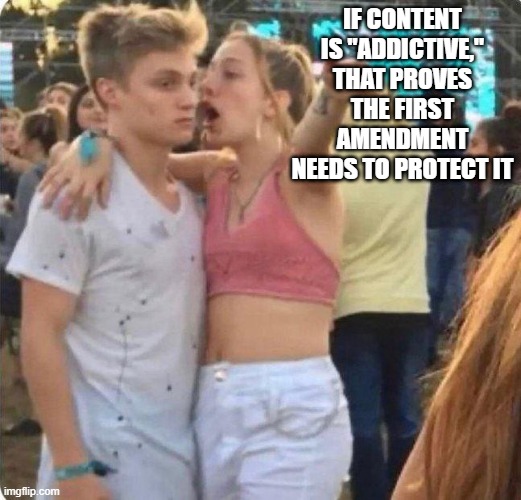Google and Roblox Defeat Videogame Addiction Lawsuit–Courtright v. Epic Games
The plaintiff claims that “video games are designed, marketed, and sold in a way that creates and sustains addiction in users.” This becomes the anchor for a mondo 260 page complaint against Epic Games, Roblox, Mojang, Microsoft, Meta, Google, Another Axiom, Rec Room, VRChat Inc., Banana Analytics, LLC, InnerSloth, LLC, and PlayEveryWare. In February, Epic, VRChat, Meta, and Rec Room had their claims sent to arbitration. In this ruling, the court grants the motion to dismiss by Another Axiom and Banana Analytics (the “Developer Defendants”) and Google and Roblox (the “Platform Defendants”).
The Platform Defendants
 The court says that Google and Roblox win based on Section 230 because “the Court would have to treat the Platform Defendants as publishers or speakers of content created by third parties in order to hold them liable on any of Plaintiff’s claims.”
The court says that Google and Roblox win based on Section 230 because “the Court would have to treat the Platform Defendants as publishers or speakers of content created by third parties in order to hold them liable on any of Plaintiff’s claims.”
The court explains:
the allegedly addictive features Plaintiff identifies are not attributable to the Platform Defendants. The allegedly addictive features identified by Plaintiff include “microtransactions and other in-game monetization systems,” “near miss[es],” “exciting animations,” “chasing,” “[f]ear of missing out,” “exclusivity” of prizes, “entrapment,” “sunk cost effect,” “loot boxes,” “rubber-banding,” “pay-to-win models,” “reward systems,” “artificial intelligence and bots,” and “dark patterns.” Those features constitute facets of ready-to-play video games that the Platform Defendants make available to users through Google Play and Roblox; in other words, the features are created and developed by third-party information content providers, which the Platform Defendants then make available. Section 230 protects the Platform Defendants from theories of liability that seek to hold them accountable for type of conduct
The plaintiff tries a panoply of arguments to get around this:
- Any profiting derived from in-game microtransactions “is done within the Platform Defendants’ roles as publishers facilitating the use of third-party content.” Cite to Coffee v. Google.
- “To the extent Roblox offers any of the allegedly addictive features to users to utilize in creating games, they are provided as tools for users—and they do not exist in the form Plaintiff describes until users incorporate them into their games.” Cite to Angelilli v. Activision.
- “providing explanatory tutorials so users understand how to operate a tool does not rise to the level of qualifying as substantial affirmative conduct.”
- “Plaintiff alleges Roblox has a “social-gaming” component that allows “users to interact with friends or other users within the game,” which creates a competitive environment allegedly further addicting users. However, allowing users to share content they created with each other also falls within Roblox Corp.’s role as a publisher.”
- “Providing an operating system for a third-party to use does not convert the third-party’s content into Google’s.”
- “making games available for purchase in the Google Play store is precisely the type of publishing activity protected by Section 230.”
The court summarizes its 230 discussion:
The conduct alleged in the amended complaint targets the Platform Defendants precisely for the role they play in making third-party created video games available to users through their platforms. Section 230 forecloses liability for this type of conduct, and it is apparent on the face of the amended complaint that all claims against the Platform Defendants must be dismissed on this basis.
Developer Defendants
The developers invoked the First Amendment, to which the plaintiff argued that it was suing over conduct, not content. The court sides with the developers. Citing the Brown SCOTUS ruling, the court says “Where a plaintiff seeks to hold a video game developer liable for the content of their products, strict scrutiny applies.”
The court distinguishes the In re Social Media Addiction ruling because “the Developer Defendants create video games, which are entitled to First Amendment protection as a whole, not in a piecemeal manner like social media platforms.” (Summarizing First Amendment protection as “piecemeal” is a pretty good sign that the prior court got it wrong).
As for the content/conduct distinction, the court says:
Plaintiff’s claims, in essence, seek to hold the Developer Defendants liable because their video games are made too entertaining by these “defective” elements. This is content-based liability that is not permitted…
the allegedly defective features, as pled by Plaintiff in this case, are properly considered video game content; they are elements and features of video games. Requiring the Developer Defendants to remove these allegedly addictive features would force them to change the content of the games to make them less enticing or enjoyable for users….
This brings to mind the meme I generated for the Angelilli case:
To get around this, the plaintiff argued that it’s just seeking the remedy of warning labels. The court doesn’t agree:
[mandatory warnings would] unconstitutionally force them to warn of potential effects of viewing protected expressive content. A mandate of this kind would violate the Developer Defendants’ constitutional free speech rights….Plaintiff’s amended complaint alleges the content of video games causes addiction; any warning about a risk of harm from playing video games would be warning about the content.
Unsurprisingly, the claims fail strict scrutiny. The court says “Preventing future addiction in children is compelling, yet the changes that are requested would apply to all users of the games and is therefore not narrowly tailored for children.” The court cites Reno v. ACLU–but is that still good law post-FSC v. Paxton?
The court continues:
the features Plaintiff identifies as addictive, stated generally as “the innovative video game monetization inventions and ideas intended to lure and addict users,” is a very broad category of content that may be addictive for some individuals but not others. To prohibit such a broad category of video game features would strongly stifle development as game developers would fear that any new game feature that users find attractive could result in significant financial liability. The chilling effect on protected expression would be broad, even for minors
Amen! I make this point about the inevitable conflicts among user subpopulations in my Segregate-and-Suppress article. But I would note that the problem isn’t just the chilling effect on publishers. It’s also a means-fit problem. The intervention doesn’t advance the plaintiff’s stated goal of “protecting children” because some kids benefit and some kids won’t. In other words, if the intervention hurts some minor subpopulations, then by definition it isn’t narrowly tailored to serve the state’s purported interest to protect minors. This is a fundamental point that infects all of the lawsuits in this genre.
As a parent, these addiction lawsuits are heartbreaking. I’m sure there are some real human tragedies behind the cases. At the same time, the defendants may not be in the causal change, and the lawsuits are censorial in intent and effect when plaintiffs try to convert standard product marketing techniques into mass-torts.
Case Citation: Courtright v. Epic Games, Inc., 2025 WL 2319148 (W.D. Mo. August 11, 2025)
BONUS: Murphy v. Roblox Corp., 2025 WL 2327100 (S.D. Cal. July 9, 2025). This is a case over minors’ purchases via Robux. Roblox sought to send the dispute to arbitration, but the court says that Roblox can’t prove that the parents agreed to the arbitration clause. Roblox has appealed this ruling to the Ninth Circuit.
Prior Blog Posts on Roblox
- Video Game Addiction Case Mostly Sent to Arbitration–Orellana v. Roblox (Catch-up Post)
- Section 230 and the First Amendment Curtail An Online Videogame Addiction Lawsuit–Angelilli v. Activision
- Roblox Faces Potentially Unlimited Copyright Liability—Robinson v. Binello
- Roblox Must Defend Illegal Gambling Claims–Colvin v. Roblox
- Roblox Sanctioned for SAD Scheme Abuse–Roblox v. Schedule A Defendants
- If TOS Formation Fails, Bad Legal Outcomes Are Likely to Follow–Doe v. Roblox

